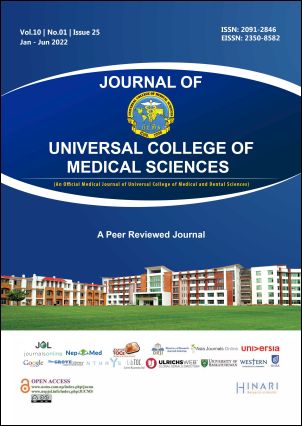Computer Vision Syndrome Among Medical and Engineering Students, Rupandehi, Nepal
DOI:
https://doi.org/10.3126/jucms.v10i01.47248Keywords:
Computer vision syndrome, Engineering students, Medical students, PrevalenceAbstract
INTRODUCTION
Computers and laptops have become an integral part of our daily life. We interact with computer screens for minutes to hours depending upon our need, for entertainment or official purposes. Using computers has become a 21st century necessity. The expansion of information technologies in recent decades has resulted in increased use of video display terminals (VDT) in the workplace. The American Optometric Association (AOA) defines Computer Vision Syndrome (CVS) as the complex of eye and vision problems related to near work, which are experienced during or related to computer use. CVS is characterised by visual symptoms resulting from interaction with a computer display or its environment. This study aimed to assess the prevalence of computer vision syndrome among medical and engineering students of Rupandehi, Nepal.
MATERIAL AND METHODS
A cross‑sectional study was conducted among final year medical and engineering college students of Universal College of medical sciences and Lumbini Engineering college, Rupandehi, Nepal. Sixty-three students were included in the study based on inclusion/exclusion criteria in one-month period (from 1st September 2020- 30th September 2020. The participants were surveyed using a validated structured questionnaire and the data were analysed using SPSS software version 20.0.
RESULTS
Out of total 63 respondents (32 medical students and 31 engineering students), more than half (60.32%) were male. Majority of the respondents (73.01%) had ocular symptoms of CVS among medical and engineering students. Among medical and engineering students the most common symptoms were redness, which was present in 51 (80.95%) of the students, followed by foreign body sensation present in 48(76.19%) and itching in 45(71.43%) of the students.
CONCLUSION
This study concludes that more than half of the students complained of any one of the symptoms of CVS. Although CVS has not been found to cause any permanent damage to the eyes, yet it’s painful symptoms can affect the performance.
Downloads
Downloads
Published
How to Cite
Issue
Section
License
Copyright (c) 2022 Journal of Universal College of Medical Sciences

This work is licensed under a Creative Commons Attribution-NonCommercial 4.0 International License.
Authors have to give the following undertakings along with their article:
- I/we declare that this article is original and has not been submitted to another journal for publication.
- I/we declare that I/we surrender all the rights to the editor of the journal and if published will be the property of the journal and we will not publish it anywhere else, in full or part, without the permission of the Chief Editor.
- Institutional ethical and research committee clearance certificate from the institution where work/research was done, is required to be submitted.
- Articles in the Journal are Open Access articles published under the Creative Commons CC BY-NC License (https://creativecommons.org/licenses/by-nc/4.0/)
- This license permits use, distribution and reproduction in any medium, provided the original work is properly cited, and it is not used for commercial purposes.




